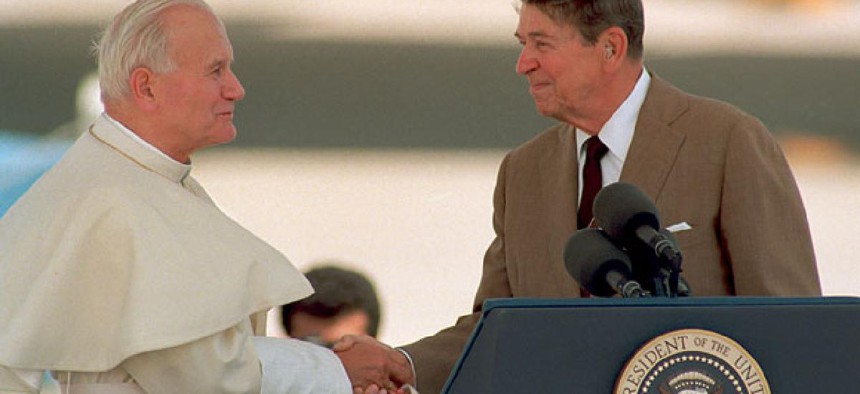Ex-Benedict: Why Popes Matter to Presidents
From JFK to Reagan, they have affected U.S. administrations. Will Benedict XVI's successor complicate life for Obama?
The history of American presidents and popes is a curious one. No American president met with a pope until Woodrow Wilson did so in 1919, and after that there was no meeting for another 40 years until Dwight Eisenhower met with John XXIII toward the end of his presidency and at the beginning of the pontiff’s short reign.
It’s hard to imagine now that John F. Kennedy, when he ran for president, had to fend off charges that he’d take orders from the Vatican and owed his allegiance to the pope. The charges came not from known racists but from the likes of Norman Vincent Peale, one of America’s popular pastors. It’s not that the America of 1960, the America of DiMaggio and Sinatra, was brimming with the same anti-Catholic sentiment that fueled the anti-immigration movements of the late 19th and early 20th century. The previous century saw the rise of the Ku Klux Klan (which was anti-Catholic as well as anti-black) and the birth of nativist parties such as the Know Nothings. But in the America of 1960, anti-Catholic prejudice still led to doubts that a Catholic could be elected president.
Pope John XXIII’s reign helped the young Massachusetts senator overcome anti-Catholicism. The pope's push toward reform of the church, his outreach to Jews, and his general openness helped promote the image of a more modern and open church that was in keeping with Kennedy’s tenure. It’s hard to remember how physically isolated popes used to be. John XXIII ended papal isolation within post-unification Italy, becoming the first pontiff to visit churches around Rome since 1870. It’s impossible to know if Kennedy would or would not have been elected without John XXIII, but his papacy was certainly helpful. During his presidency, Kennedy met with the pope but generally kept his distance. Jackie Kennedy had to push to get her husband to send a letter to the pope applauding his calls for global peace. Some historical accounts of the Cuban missile crisis point to the Vatican’s call for peace during the week that tensions almost flared into nuclear war. It was a call that was surprisingly reprinted in the Soviet organ Pravda, not known for its religious coverage, and it helped give Khrushchev a hook for backing down.
Likewise, for Ronald Reagan, the ascension of Pope John Paul II in 1978 added a boost to his anticommunist rhetoric. The first Polish Pope, John Paul II’s stand against communism and his celebration of Masses in Poland helped spur the strikes at the Gdansk shipyard and the Solidarity movement that led to the overthrow of the Polish government. Reagan’s notions of rolling back Communism, which seemed an affront to all foreign policy thinking since World War II, had a new legitimacy. The pontiff also challenged Communism in a fundamental way, not only through sermons but through travels to the Warsaw Pact.
It’s hard to imagine the next pope having a big influence on President Obama. Communism is gone, and Catholics are woven into American life. But history has a way of being unpredictable. A pope who launches an aggressive push to convert Islam, reunites the Russian Orthodox Church, or promotes civil disobedience among illegal immigrants would see the impact of his decrees felt not only in Vatican City but in Washington, too, and upend life for a president trying to deal with the Muslim world, contain Vladimir Putin, and pass an immigration bill. In American politics, the Vatican looms smaller now, but it still looms.



